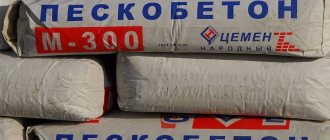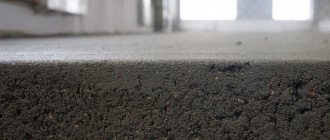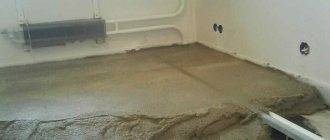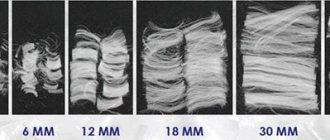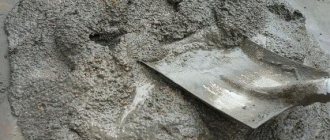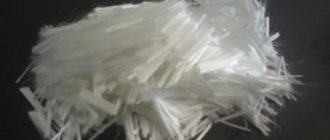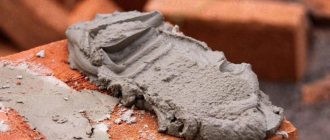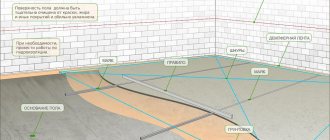To make sand concrete, only 3 main ingredients are used: cement, sand and water. In this case, the addition of coarse aggregates such as crushed stone, gravel or others is excluded. The absence of coarse aggregate makes it possible to produce a material with a very dense and uniform structure. Compared to other heavy concretes, sand concrete is much more durable and is characterized by better physical and mechanical properties for samples of the same strength grade.
In addition to the basic components, a plasticizer is also added to sand concrete, which increases the plasticity of the solution. As a result of its use, the solution gains better workability and it becomes possible to add less water. This has a positive effect on the strength of the finished concrete layer while maintaining the amount of cement used, the most expensive ingredient in the mixture.
How to mix sand concrete M300 and M500 - features
The second name of the material is fine-grained concrete. This is a building mixture that consists of sand, cement and filler. The latter is played by sand, limestone, and crushed stone.
The mixture is used in construction for internal and external work: for sealing cracks in brickwork, for pouring concrete bases of pillars and floors (including heated ones), for creating foundations and bases, when equipping stairs and house paths in the country.
The M300 brand is the most versatile. It is highly durable (1 sq. cm can withstand up to 300 kg) and is used in the construction of concrete structures and monolithic buildings, pouring floors, and producing expanded clay. Sand concrete M300 is distinguished by its composition and proportions of cement - it accounts for a third, the rest is occupied by sand and plasticizers. For exterior finishing, the amount of concrete is increased.
Brand M500 is the most durable of all brands: 1 sq. cm can withstand more than 400 kg of load. It is mainly used in mass industrial construction. The composition and proportions of sand concrete differ from others - more than 70% is cement.
Do I need to add cement?
It’s easy to learn how to mix sand concrete with M500 cement. The finished powder is mixed with the required amount of water to obtain a ready-made solution.
However, many builders feel that additional cement needs to be added to the mixture. Manufacturers do not recommend doing this. High-quality mixtures that comply with GOST are already completely ready. By pouring in excess concrete, you can get a low-quality solution that will not have the declared properties. When making a mixture at the factory, the material undergoes several checks, that is, the probability of error is almost zero.
Additionally! It is completely unacceptable to add cement after pouring, when it begins to dry and bonds form in the structure. This will lead to a strong decrease in strength and the appearance of cracks.
Reviews from experts
The M300 40 kg reviews are almost all positive, mostly left by professional builders, which speaks to the quality of this construction equipment.
- fineness;
- fits well;
- you can make a thick layer;
- lasting;
- cracks and shrinkage do not appear.
Major renovations often require leveling the floor. Today this can be done dry or wet.
But as practice shows, not all technical characteristics that are indicated on bags of sand concrete correspond to real parameters. Sometimes we come across the fact that the M300 brand mixture has very coarse filler.
Recently, for wet screed, we have been choosing etalonstroy sand concrete grade M300. This building mixture meets almost all modern requirements, which is extremely rare these days.
A very liquid solution will make the screed brittle, and when it dries, cracks will form and shrinkage is possible, and a very thick solution will peel off from the base.
From Etalon sand concrete you can make a reliable and high-quality screed with a thickness of more than 10 cm, which will not crack or peel off.
In what cases is adding cement harmful?
Sand concrete M300, the proportions of which are strictly verified at the factory, often looks fragile. Builders want to add cement to make the composition stronger, but this cannot be done. Any violation of the proportions will lead to a change in the characteristics of the solution and loss of strength.
It is prohibited to try to change the composition when using the material to fill a floor or staircase, that is, in potentially dangerous situations. Experimentation is allowed when designing street paths. If they crack, it will be noticeable, and they will not fail themselves.
Material Information
Description and benefits
Sand concrete is a construction mixture that includes components such as Portland cement (from M300 to M500), sand and chemical additives that improve the performance of the material.
Photo of bulk material
According to the GOST classification, depending on the grade, sand concrete is classified as fine-grained or coarse-grained concrete.
This material has a number of advantages in use:
- Precisely measured and indicated proportions of ingredients.
- Easy to prepare and lay the mortar, allowing you to save on the involvement of master concrete workers when screeding yourself.
- Excellent sound and heat insulation characteristics after hardening.
- Long service life.
- Corrosion resistance.
- Frost resistance, resistance to heat and temperature changes.
Surface of frozen material
Composition analysis
From different manufacturers, the composition of sand concrete, even of the same brand, may differ due to the use of different additives.
However, the main components can be identified:
- Portland cement.
- Washed sand, river sand, as well as coarse sand (up to 3 mm).
- Granite chips or screenings.
The proportions of the components are approximately 1 part cement to 4 parts of all sand fractions (and granite chips, if indicated in the composition).
Additives to improve properties
Additives play a special role in imparting performance properties to the material:
- Plasticizers.
- Hardening accelerators or retarders.
- Antifreeze additives.
Production Features
The main document regulating the grade indicators of sand concrete is GOST 7473-94. Today, brands from M-150 to M-500 are available on the market. The marking shows the size of the sand fraction, as well as the rate at which the mixture gains critical strength.
In answer to the question “Which sand concrete is better for floor screed?” experts agree: for most residential premises, the M-300 brand is optimal. Thanks to coarse sand, the surface is quite durable, while the cost of the material is quite affordable.
Most common brand
The quality of the sand concrete mixture is controlled by the manufacturer and depends on many factors.
Among them:
- The quality of the components.
- Quality of cleaning and drying of components.
- Features of the fractionation procedure.
- Compliance with the sequence of mixing the components.
Based on the analysis of the composition, we can conclude that you can make sand concrete yourself. Naturally, its price will be significantly lower, but the quality will also drop, since we will not be able to provide the entire technological process for producing the mixture ourselves.
And it is almost impossible to control the quality of cement and sand, the purity of water and the uniformity of mixing without proper preparation and equipment.
The conclusion is simple: if you don’t want to pay twice, buy industrially produced material.
Calculation of the amount of sand concrete for screed
When calculating the amount of sand concrete and its proportions, it is important to take into account the thickness of the floor and the total weight with all additional parts, such as reinforcement. The height of the screed must be at least 3 cm, especially when installing a “warm floor”. It is not recommended to make the layer thinner, as due to temperature changes the surface may crack, which will lead to a decrease in service life. When installing a “warm floor,” the volume that the pipes and the entire system will occupy is additionally subtracted.
If the screed is more than 8 cm, it is additionally reinforced with metal mesh or reinforcement. Their weight must be included in the calculation, especially when pouring is carried out in a multi-story building.
Many manufacturers have online calculators on their websites for accurately calculating the amount of concrete. You only need to indicate the area and thickness of the fill, select the name of the mixture and packaging. When calculating, the exact number of bags required will be indicated.
An independent calculation will be made in several steps (for example, let’s calculate the quantity for a floor 5 cm thick and an area of 10 sq. m):
- First you need to clarify the ratio of sand and cement. For example, with a ratio of 3:1 you will need 3 parts sand and 1 part mixture.
- The packaging must indicate the amount of mixture per 1 square meter. m with a thickness of 1 mm. For example, if the mixture requires 2 kg, then sand - 6 kg.
- Room area in sq. m multiplied by the thickness in mm and the amount of cement, then by the amount of sand. Calculation for concrete: 10 * 50 * 2 = 1000 kg. For sand: 10 * 50 * 6 = 3000 kg.
Additionally! If the floor has a difference in thickness of more than 1 cm or has dents of this depth, approximately 10% should be added to the total weight.
It is important to purchase the required quantity at once, since the characteristics of the mixture may vary even from the same manufacturer.
Pros and cons of floor screed with expanded clay
pros
Using this technology, you can level out any unevenness and distortions of the base, raising the floor level to the desired height. Perhaps this is the main advantage of using granules. After all, pouring a thick layer of concrete is too expensive and difficult. And in some cases it is even dangerous: in very old houses, the floors may not withstand the weight of hardened cement reinforced with reinforcement.
This subfloor is resistant to temperature changes and the difference between temperatures inside and outside the room. This matters for foundations on the first floors: it is always colder under the floor than above. Moreover, both in private buildings and in city apartments.
The coating made of clay granules allows air to pass through, which allows you to create a healthy microclimate in the living room, which is especially useful for those who have problems with the breathing apparatus. Of course, concrete also has air permeability, but to a noticeably lesser extent. Forming a base that includes a light ceramic backfill is easier than a regular concrete one, so you can do it yourself without involving specialists. And, best of all, it will cost less.
Minuses
A subfloor with expanded clay in concrete cannot be small in thickness, at least 10 cm, and in some cases 15. Some will be pleased with this fact - additional insulation will not hurt. But if the apartment has low ceilings, then such a high floor with a finishing layer will noticeably hide the living space
Composition and manufacturing technology of sand concrete
The material can be purchased ready-made and diluted with water in the specified proportions. It can also be mixed at home using a few ingredients. You can find out how to mix sand concrete M300 according to the instructions on the package.
How to prepare the solution yourself
You can make sand concrete yourself. It is important to maintain the required proportions and use high-quality materials. There is no point in saving on them: the better the components, the better the concreting result will be.
The material consists of:
- Cement. Experts recommend choosing Portland cement, which consists of crushed gypsum and clinker. Suitable brands from M300 and above.
- Sand. Its fraction depends on the further work: coarse is used for filling the floor, and fine for plastering. Use only purified and carefully sifted sand.
- Plasticizers. These are special additives that allow you to obtain certain properties: frost resistance, moisture resistance. They also increase the strength and density of the solution.
Additionally! When using plasticizers, it is important to strictly observe the proportions. They are indicated on the packaging.
Proportions in mass fractions
When preparing the composition, proportions must be observed. Any deviation can lead to unpleasant and irreparable consequences, which can only appear after drying.
The standard proportions are as follows: for 1 part of concrete take 2-4 parts of sand. The amount of plasticizers is indicated on the packaging. Some need to be added to the finished solution, on average they make up 2% of the mixture. For every 10 kg of dry mixture, 1.5-1.8 liters of cold water are needed.
The dry parts are mixed with a mixer or shovel (you can only use your hand) in a bucket or other container until smooth. Then dilute with water to the required state. At the end, plasticizers are added if necessary.
Sand concrete is a construction component that is used both when pouring floors and for filling cracks and plastering. The scope of its application depends on the specific brand and its composition.
Features of the use of sand concrete grades
What is cement - properties, what is it made from
What is concrete made of - composition and proportions
House made of monolithic expanded clay concrete - how to make it, proportions
Source
How to prepare the solution yourself
Preparing the solution yourself begins with calculating the cement-sand ratio and the proportion of additives. Basic components:
- cement grade M400;
- sand with a fraction of 3-5 mm, which is pre-washed to remove dust and dried;
- plasticizers (change fluidity, adhesion of components and bases, increase concrete density, frost resistance and other indicators).
The strength of sand concrete depends on the quality of cement. As a rule, the composition of dry mixes includes Portland cement M400, two thirds are sand and plasticizers, the rest is cement.
The required volume of water for a solution of M300 sand concrete should be clarified in the manufacturer’s manual.
Dry to liquid ratios for some popular brands:
- sand concrete Stone flower: per 1 kg - from 0.12 to 0.20 l of water;
- Dauer: for 1 package 25 kg - from 4.8 to 5.2 liters of water;
- Baumax: for 1 package 25 kg - from 4.8 to 5.2 liters of water;
- mixture M150: per 1 kg - 0.15-0.18 l of water.
What is sand concrete made of?
The characteristics of sand concrete m300 (composition, proportions 1 m³) are standardized by GOST 7473-94.
High-quality dry mixture contains:
- Portland cement PC500 D20/PTs400 D0;
- fractionated dry sand, with a combined composition of fractions (particle size 0.80-4.0 mm);
- other additives (frost-resistant, microsilica, fiberglass) are introduced at the discretion of the manufacturer.
Depending on the sand used, M300 grade material is used to carry out certain work:
| Sand, particle size, mm | Characteristic | Application |
| Small – 0.80-1.20 | High wear resistance and strength characteristics | Carrying out critical masonry and other external work, light floor screed 50.0 mm, installation solutions of increased strength |
| Average – 1.80-2.20 | Increased resistance to operating loads | Implementation of interior work, laying curbs, paving slabs, erection of Euro fences, screed up to 100 mm, “warm floor” systems |
| Large – 2.50-4.0 | Moderate moisture absorption | Construction of slab, strip and column foundations, plinths, pit floors, without restrictions on thickness using reinforcement |
Purchase from Bauff
By contacting our company, each buyer finds those building materials that will help him decorate the walls of his house, or in the process of pouring full-fledged foundations for the structures being built. On the company's blog you will find any answer regarding other technological aspects. For example, you can read about how thick a layer of screed building material is applied so that the surface is as durable as possible and gains optimal resistance to negative factors.
If you need a small volume of concrete consistency, then everything you need can be ordered from Bauff. We also have a wide range of M300 sand concrete (and other varieties), which is a ready-to-use powder combination. It can also be used when pouring a floor screed in any premises, a full-fledged foundation monolith, or to cover the structural components of a building that are being repaired.
Leave a request on the website, or contact us at one of the numbers provided in the “Contacts” section. Competent and responsible managers will promptly help you order good original products from leading suppliers. Also, just in case, you can discuss proportions and other technological nuances with them in order to purchase the right product. They will notify you about the availability of goods, tell you about the terms of payment and delivery, and also mention warranty obligations. Waiting for you!
Instructions for use
Preparation of the working mixture is subject to the following principles:
- To mix the solution, use clean cold water, up to +20°C;
- Dry construction mixture is poured into a separate container filled with liquid and gradually stirred. For mixing, it is convenient to use a drill with a special attachment;
- the result should be a viscous, plastic and homogeneous mass;
- the solution is left for 5-10 minutes. and is used for its intended purpose.
Fixing beacons for screeds
Lighthouses are placed in one horizontal plane of the floor. Such beacons for leveling the floor are special landmarks made of guide rails. It is along them that the filling process is carried out as a rule and thus a smooth and even surface is obtained.
The installation of beacons should be done carefully and accurately, since the horizontalness of the base for finishing depends on this. The guides can be made from a special aluminum profile.
The beacons are mounted in a certain sequence:
- The zero level is determined, usually it is 5 centimeters above the highest point of the surface of the rough foundation.
- At a distance of 30-40 centimeters from the walls, draw a line, at the ends of which holes are drilled using a hammer drill, choppers are placed in them and screws are screwed in so that their heads are at the zero level.
- Then a profile is placed on the caps and a rule is applied to it. If necessary, adjust the height of the screws to achieve a horizontal profile.
- A strong position of the beacons is ensured using a small amount of gypsum mixture. The gaps between the landmarks should not exceed the length of the building rule plus a 10-20-centimeter margin on each of its sides.
- After completing the fixation of all beacons, use a level to once again check the horizontalness of the base surface in all directions.
Consumption
To determine the amount of material required, you need to focus on the range of work and instructions for use. If the construction of foundations is implied, the volume of dry mixture is calculated; if screed or plastering is required, calculations are made by area.
Sand concrete M300 consumption per 1 m³:
- to fill 1 m³ of volume you will need 1.50-1.70 tons of dry mixture;
- on average, you will need 30 bags of mixture weighing 50 kg;
- Knowing the volume of the working area, you can calculate the total material consumption.
The total financial costs for pouring 1 m³ of surface will be 5.1 thousand rubles. Sand concrete (price 170r/50 kg) will cost less than heavy concrete.
Consumption per 1 m² of screed
The following initial data are required for the calculation:
- room area, m²;
- screed height, m. If the height is presented in cm, it is converted to m - 1 cm = 0.01 m;
- coefficient is assumed to be 2.0 (per cube of the finished solution will require 2.0 tons of dry mixture).
Example: for rooms of 25 m² with a screed height of 7.0 cm, the material consumption will be – 25 * 0.07 * 2.0 = 3.5 t (70 bags of 50 kg). To determine the average layer thickness along the entire perimeter of the room, you can use a laser builder . If we take into account the presented consumption and costs for sand concrete M300 (price per bag - 170 rubles), the total cost of pouring the screed will be 11.9 tr.
The calculation is based on the rough coating. On average, consumption per 1 m² (with a thickness of 10 mm) is 18-30 kg (depending on the sand concrete manufacturer). When working, it should be taken into account that it will not be possible to fill a layer less than 50.0 mm.
If you plan to purchase M300 sand concrete, the price per bag (50 kg) will be at least 170 rubles. Based on the total volume of construction, it is easy to estimate the final level of costs.
The material is very easy to manipulate: all stages - preparation, mixing, pouring - are available for independent execution , however, it may be necessary to hire a small team of workers.
Experienced builders recognize the advisability of using sand concrete when carrying out interior and exterior work. However, the home master should take into account: in order for the mixture to retain all the declared characteristics, it is necessary to comply with the storage and transportation conditions.
Practical production of sand concrete m300, its composition and proportions per 1m3 are shown in the video:
Calculation of sand concrete costs
The characteristics of this material allow it to be used in creating wear-resistant surfaces, leveling them and when laying stone, brick and tiles. In addition, it is used as a composition with fine grains for concreting.
The main conditions for this are high-quality preparation of the surface: it is necessary to clean it well, level it and then prime it, and treat it with agents that resist the development of fungus.
Also, different manufacturers may recommend the use of concentrated additives intended for specific purposes: from strengthening compounds to antibacterial agents.
For 1 m3 of concreting, 25-30 bags of dry mixture without adding filler will be required.
When using fillers (it is permissible to add fine gravel, fine crushed stone, sand to the solution), the properties of the finished concrete change and the consumption of the dry mixture becomes less.
Dry mixture x 6cm = 120kg, material costs for the entire area of the room will be 7200 kg, 150 bags of sand concrete m 300.
Calculation of the amount of sand concrete for screed
The building mixtures of the group are sold in big bags, bags of 25, 40, 45, 50 kg. The offered packaging is convenient for the ability to purchase bulk materials both for home repairs and for large construction projects. You can calculate the amount of sand concrete for floor screed without involving specialists using the following formula:
Layer thickness (m) x object area (sq. m) x coefficient 2.0 (based on the calculation that 1 m 3 of prepared solution requires 2.0 tons of mixture). So, for a room of 15 m2 with a screed thickness of 5.0 cm (i.e. 0.05 m), the consumption of sand concrete will be 15 × 0.05 × 2.0 = 1.5 t (30 bags weighing 50 kg).
Frequently asked questions when pouring cement-sand screed
An important question: how long does it take for the screed to dry? Concrete reaches 70% of its brand strength during the first week, the remaining 30% is achieved in 21 days. Those. 100% brand strength of the screed is achieved in 28 days.
Is it possible to independently use plasticizers or other chemical additives for concrete? It is possible, but you should very strictly follow the proportions specified in the recipe. Since additive consumption is measured in milliliters or milligrams, it is very difficult to take accurate measurements at home. Therefore, for special construction work, it is recommended to buy ready-made building mixtures.
Characteristics of dry mixtures
Ensuring the mechanical and physical qualities of a building material—freezing/thawing cycles, consistency, plasticity, mobility, strength, density—depend on proper calculation of the components in the composition. The more correct the proportions and the better the quality of the additives, the more tolerant the concrete is to mechanical loads. The recipes of the listed brands are precisely verified, which distinguishes them favorably from homemade formulations.
The M150 mixture consists of sand, Portland cement, mineral powder, plasticizers and additives. It is used for plastering and masonry of unloaded or moderately loaded building structures. The mixture has an optimal ratio of cost and quality. This building material is widely used for primary plastering work - leveling walls and ceilings.
Sand concrete M300 is in demand in all types of construction work for the climatic conditions of the south, middle zone and north of Russia. In liquid form, it is designed for significant loads, for example, pouring foundations, floors, and is also suitable for leveling and arranging rough floor screeds. The resulting structures are durable, do not shrink, are moisture-resistant, environmentally friendly, and have a long service life. Examples of relationships between quality and brand:
- Sand concrete Baumax. The viability of the solution is 45 minutes, the compressive strength after 28 days is 300 kg/m 2, the adhesion strength to concrete is 0.8 MPa;
- Dauer sand concrete. Viability 45 min, compressive strength 300 kg/m 2, adhesion 0.8 MPa;
- Sand concrete Stone flower M300 (50 kg). Viability 120 min, compressive strength 30.0 MPa, adhesion strength - 0.3 MPa.
Laying coatings (laminate, linoleum, tiles) is possible after 5 days. Frost resistance of the building material is about 50 cycles. The temperature of the base on which the layer is applied and the air is + 5 - +30 degrees, hardening time is 2-3 days. Considering all these conditions, you can begin construction.
What is a screed and its main functions
Concrete floor screed is a concrete layer between the rough base and the finishing floor covering. For arrangement and filling, various technologies are used, involving the use of concrete and cement mixtures in different proportions.
Components and elements when aligned
In private and suburban construction, a screed can perform a number of functions:
- leveling a concrete or wooden base;
- protection of the rough foundation and uniform load distribution;
- communication layer for water and electric heating systems;
- protection of traditional communication systems.
Less commonly, a concrete screed device is used to create a certain angle of inclination, for example, when leveling floors in bathrooms, showers, etc. This approach practically does not differ in anything from traditional construction technologies, except for the method of placing beacons and leveling the solution.
Main types of leveling screeds used in private construction
Depending on the components of the mixture used and the method of preparing the base, the following types of screeds are distinguished:
- Connected - the poured solution is in direct contact with the base of the subfloor. This method is performed only at low humidity levels, using a homogeneous concrete mixture. Mainly used for leveling interfloor floors.
- Separating – pouring is carried out on a layer of waterproofing material. They are used when leveling floors on lower floors, when laying floors on the ground and in other cases where there is partial or constant exposure to moisture. Rolled materials, bitumen-polymer mastics and films are used as waterproofing.
- Floating - used when it is necessary to heat and sound insulate the floor, partially reduce noise from walls and adjacent ceilings. Using this technology, the solution is poured onto a layer of thermal insulation material and does not come into contact with the rough base and load-bearing walls. The minimum layer of the mixture to be poured should not be less than 50-60 mm with mandatory intermediate reinforcement.
The arrangement of the screed can be done by pouring one, two or more layers. Filling in one layer is used when leveling floors in industrial, utility or non-residential premises.
Multilayer structures are used for more thorough leveling, when the first layer smoothes out differences in the heights of the rough foundation, the second and subsequent ones – leveling for the final flooring and floor covering.
After pouring and drying, a smooth and seamless coating is created, which is suitable for laying any facing materials
Various components can be used to mix the floor screed solution. The traditional type of mortar is a homogeneous cement-sand mixture used when pouring thin-layer or multi-layer screeds.
If it is necessary to improve the heat and sound insulation qualities, polystyrene foam chips or expanded clay fractions are added to the solution. There are ready-made thermal insulation compositions - expanded clay concrete.
Such mixtures are distinguished by high heat-saving qualities, but require pouring an additional leveling layer. To obtain higher strength characteristics, compositions with fiber fiber are used.
Breeding dry mixtures
Before starting work you need to prepare:
- container of sufficient volume;
- water without impurities with a temperature not exceeding 20 degrees;
- drill and mixer attachment.
Carefully pour the contents of the bag into the water with constant stirring, and not vice versa. You should work with a construction mixer at low speed or by hand. The result is a plastic, viscous, homogeneous mass.
The solution is infused for 3-10 minutes (according to the instructions), at which time the process of interaction of the components is completed. Stir again before use.
The finished solution must be used within 1.5 - 2 hours, otherwise it will lose its plasticity, dry out, and may crack after drying.
Cooperation with AlfaCem
The AlfaCem electronic product catalog contains a list of the most popular types of dry mixtures for different types of construction work. Their price depends on the ratio of components and type of additives. In special sections of the site you will find detailed answers to important questions about payment, discounts and delivery of materials.
We organize delivery of ordered building materials by group transport from warehouses in the cities of Zhukovsky and Kolomna. It is carried out by machines with a lifting capacity of up to 10, 20, 24 tons, unloading with a manipulator from 5 to 10 tons, deliveries to remote regions by rail. Additional payment is taken for transportation within the Central Federal District of Russia. The final cost is calculated by the manager after processing the order, taking into account the distance to the object.
Loading of products is carried out by the supplier, unloading by the buyer. To unload large volumes of products, we provide a manipulator upon prior request. Delivery of any volume is carried out around the clock. Check with the manager about the possibility of receiving materials on the day of application. We guarantee prompt order processing, packaging and delivery.
Source
Nuances when calculating
The screed on the floor surface is a special solution that contains sand, water, and cement, all of which must be in strictly defined proportions. The quantity and consumption of basic materials are directly proportional to the requirements that the final product must have
It is very important to calculate consumption standards correctly, since the quality of the screed directly depends on this. The main calculation for the solution should be carried out only taking into account all parameters per 1 m2 or m3, and not the entire area of the room
When carrying out work, cement solutions of various brands can be used, it all depends on the environmental conditions. About 400 kg are consumed for a mortar of M100 grade to create a base from M400 cement. If you recalculate per m2, you get about 45 - 50 kg - cement consumption - with a layer thickness of 10 mm. is considered a traditional brand, the most popular when installing screeds. Brand M200 - more reliable and durable - is used for leveling the subfloor in warehouses or garages.
This can lead to severe peeling and significant cracking of the substrate. In order to avoid this during the work, it is necessary to periodically moisten the cracked area with water at room temperature.
Separately, I would like to draw your attention to choosing a supplier of building materials. We categorically do not recommend buying cement from a contractor, as you will not know in what conditions it was stored, how long it was in the warehouse or machine
Due to long storage, due to lack of storage conditions, cement can lose up to 15% of its activity per month. After all, its most dangerous enemies, moisture and carbon dioxide, are in the atmosphere. The decline in activity also slows down the process of cement hydration.
Here it is worth paying attention to the fact that the higher the initial activity, the faster it is lost. Let's look at an example
You bought grade 500 cement. It was stored in a warehouse for two months. And it can already show the 400 mark... Store for another six months.... And you can just throw it away...
Of course, a simple layman may object, but if cement is stored in ideal conditions: in moisture-resistant packaging and a dry room. Alas, this process cannot be completely stopped, it can only be slowed down. This requires appropriate storage conditions for cement: type of storage, ambient humidity.
This is an ideal place to buy, since they take cement for orders, directly from the warehouse of the manufacturer’s plant, and accordingly they have nothing lying around.
Retail chains have warehouses, and here the chain begins: manufacturer - storage warehouse, - transportation to the warehouse of the retail chain, again storage in the warehouse until the moment of sale, then transportation again, this time to the seller.
The risks of receiving low-quality goods increase, 2 storage points, plus 2 transportation.
Buying from an online store cuts off one link, the cement is delivered to you directly from the factory, unless of course the seller is a small intermediary; as a rule, the role of the seller is performed by a contractor, offering turnkey work with his own material.
Delivery is very well organized, and cement is guaranteed to arrive fresh from the manufacturer to the customer.
in Moscow, Yekaterinburg, Perm, Surgut, Nizhny Tagil and Chelyabinsk.
Screed
- a good base for any final floor covering. It is convenient to hide any communication systems under it, arrange ventilation and thermal gaps, as well as insulation and waterproofing. The consumption of floor screed per m² depends on its functions and the method of arrangement.
Production technology
The mixture is produced in factories. The process begins with designing the composition of the sand-cement mixture. Much attention is paid to the quantitative composition of elements (a change in proportions entails a change in the properties of the product).
Based on the existing design, the ingredients that make up the product are mixed. The properties of the future solution are calculated in advance.
- Weighing components (or volumetric measuring).
- Placing ingredients into a concrete mixing device with forced mixing to obtain a homogeneous mixture of elements that differ in viscosity and hardness.
- The mixing process continues until a homogeneous state is formed.
- Packaging of the finished product.
If the technology and transportation rules are followed, the density of M300 sand concrete, viscosity and other physical properties do not change.
